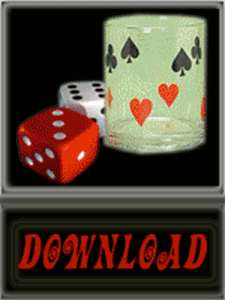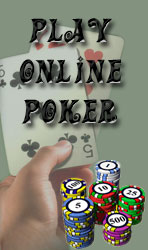Pokerwiner.com → Lessons of poker
SEMI-BLUFF AND PURE BLUFFS
A pure bluff is a bet, which, if called, has no chance of winning in a showdown.
A semi-bluff is a bet with more cards to come which, if called, is probably not the best hand at the moment but has a reasonable chance of becoming the best hand. Many expert players believe their bluff should have negative expectation. They see them as a form of advertising that will lead to their being called on other occasions when they do have the best hand. However, I believe pure bluffs should have no worse than zero expectation as I shall explain in more detail in a later chapter.
At the same time, I agree that bluff, your opponents will always know you have a legitimate hand when you bet. They will be likely to play correctly on the basis of what you have in your hand, which is to their advantage and your disadvantage, according to the Fundamental Theorem of Poker. Since it is correct to bluff occasionally so that you don’t give away too much information when you bet with a legitimate hand, the question is when to do it. Clearly, you cannot establish a regular pattern of bluffing. Observant opponents will soon pick it up, and you will be caught bluffing too often to make it profitable. Rather than try to guess when to bluff, especially against tough players, use your cards to randomize your play. (See Chapter Nineteen, “Bluffing and Game Theory.”)
In early betting rounds, with more cards to come, the most convenient and profitable way to us your card is to bluff when you have the kind of semi-bluff hand s I have been discussing. Then you are still but you have the extra advantage of sometimes winning even when you do get caught.
There are numerous situations where a pure bluff would not work often enough to be profitable, but where a semi-bluff is more profitable than simply checking and hoping to draw out and win in the showdown. Suppose you are playing $10-$20 holdem. After six cards your hand has fallen apart; you have no win.
There is one more card to come and $60 in the pot. So if you bet $20 as a pure bluff against a single opponent, you are getting 3-to-1 for your bet when he folds. The key question, then, is whether that opponent will fold often enough to make a bluff profitable in terms of the pot odds you are getting. Let’s say you expect he will fold 20 percent of the time. That is, he will call four times out of five and fold once. Thus, the odds against getting away with a bluff are 4-to-1, while you are getting only $60-to-$20 or 3-to-1 odds when you bet.
Therefore, the play has negative expectation. In the long run it is unprofitable. (This is assuming you give up your bluff when you’re called and don’t bet on the end.) Now instead of a busted hand with one more card to come, let’s assume you are holding a hand that you assess as having a 30 percent chance of winding up the winner something like, say, a four-flush and a small pair. Again there is $60 in the pot, and you figure you have a 20 percent chance of stealing that $60 right there if you come out betting against a single opponent. Readers profitable play. In fact, it is more profitable than simply checking and hoping to win in the showdown.
To make this point absolutely clear, we’ll do some arithmetic. We’ll assume that if you check after six cards, your opponent will check behind you, and we’ll ignore bets on the end on the assumption that you will fold when you don’t make your poker hand and your opponent will fold when you do. We’ll take 100 identical situations where you check and hope to draw out and 100 situations where you make a semi-bluff bet. Take checking first. With $60 in the pot odds and a 30 percent chance of winning, you will average winning $60 30 times for a total of $1, 800.
What happens when you bet? Well, since your semi-bluff has a 20 percent chance of making your opponent fold, you will average winning $60 immediately 20 out of the 100 times you try it for a total of $1,200. Of the 80 times your opponent call your bet, you will average winning $80 (the $60 already in the pot plus the $20 called) 30 percent of the time and losing your $20 bet 70 percent of the time.
That work out to an $80 win 24 times and a $20 loss 56 times for a net win of $800. So after 100 identical situations, you will average winning $1,200 when your opponent folds, plus $800 when he call s for a total of $2,000, which is $200 more than you would win by checking. That comes to only 42 per hand, but it is with such small edges that you increase you hourly rate and your profits at the end of the month and the year.



